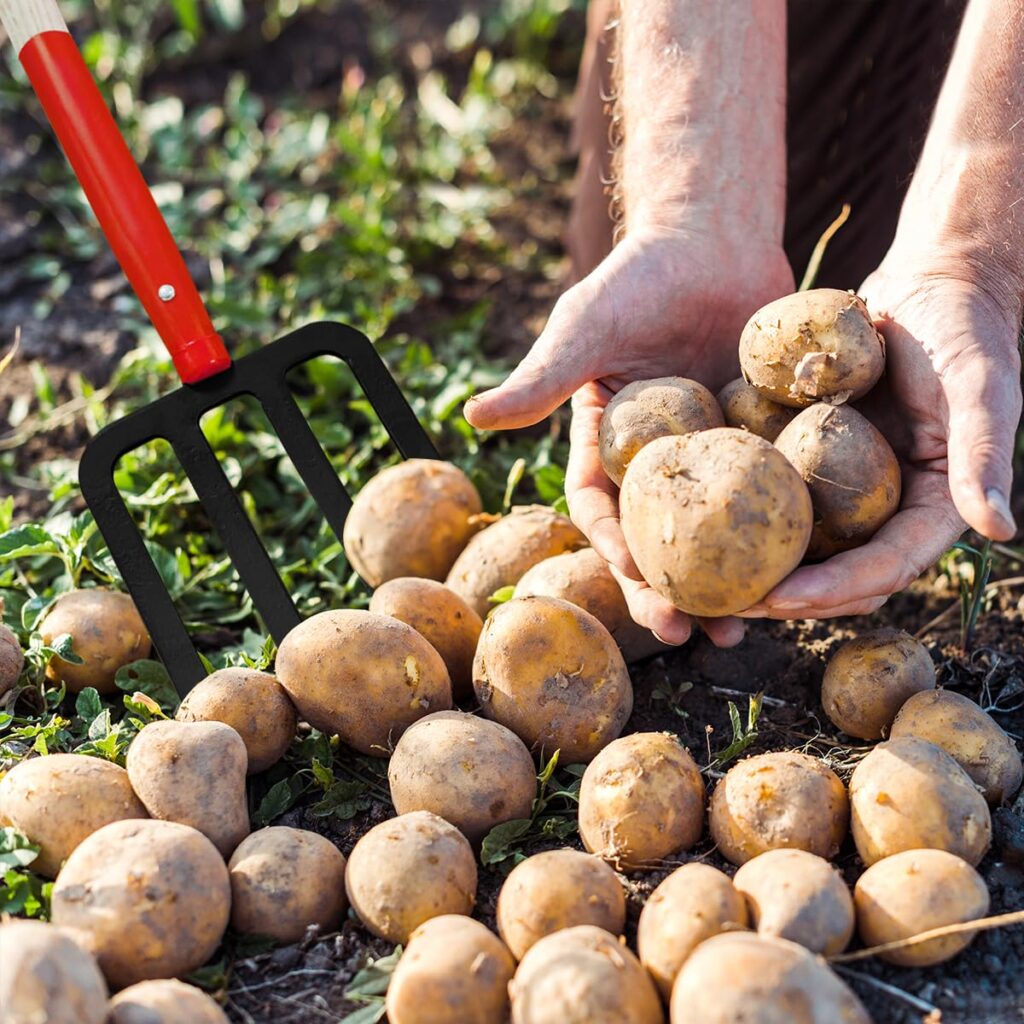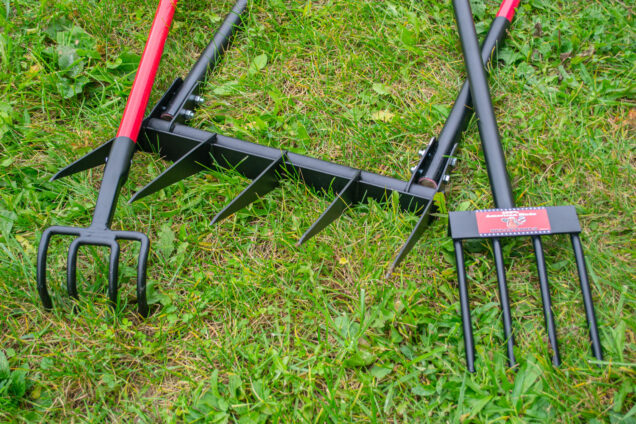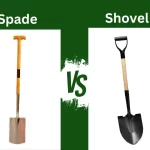A garden digging fork is a sturdy gardening tool designed for loosening, aerating, and turning over soil. Unlike a spade or shovel which has a broad blade, a digging fork features a series of strong, thick tines that can penetrate and break up even heavily compacted earth.
The primary purpose of a digging fork is to prepare soil for planting by loosening it and allowing air to circulate. This aeration encourages beneficial microbes and insects while also making it easier for plant roots to spread. Digging forks are ideal for mixing in amendments like compost or manure into garden beds without overly disturbing the existing soil structure.
Digging forks are distinct from pitchforks used on farms, as garden forks have shorter, sturdier tines spaced more closely together. This compact design allows for precision digging in tighter spaces like vegetable gardens and flower beds. The tines are also flattened with slight curves to better grab and lift soil.
Table of Contents
Types of Garden Digging Forks
Garden digging forks come in a variety of styles, materials, handle lengths, and tine configurations to suit different gardening needs and preferences.

Styles:
- Border Fork: Featuring a short, sturdy design with flat tines, border forks are ideal for edging garden beds and lawns.
- Potato Fork: With flat, oval tines spaced further apart, potato forks make it easier to harvest root vegetables like potatoes without damaging them.
- Spading Fork: The most common type, spading forks have rectangular tines and a sturdy design suited for general digging and turning soil.
Materials:
- Stainless Steel: Rust-resistant and durable, stainless steel forks are low-maintenance and long-lasting.
- Carbon Steel: More affordable than stainless steel, carbon steel forks require regular oiling to prevent rust but are strong and reliable.
- Aluminum: Lightweight aluminum forks are easy to maneuver but may not be as durable as steel options.
Handle Lengths:
- Short Handles (Around 28 inches): Compact and maneuverable for raised beds or tight spaces.
- Long Handles (36 inches or more): Provide extra leverage and reach, reducing back strain during prolonged digging.
Tine Configurations:
- Square Tines: The most common shape, square tines effectively loosen and lift soil.
- Curved Tines: These gently curved tines are designed to slide under roots or weeds more easily.
- Number of Tines: Typically ranging from 4 to 6 tines, with more tines providing increased soil contact.
With so many variations available, gardeners can select the perfect digging fork tailored to their specific needs, soil conditions, and physical abilities.
Uses for Garden Digging Forks
Garden digging forks are versatile tools with a variety of uses in the garden and landscape. Their primary purpose is for digging and cultivating soil, but they can also be employed for other gardening tasks:
Digging – The sturdy tines of a digging fork easily penetrate and loosen compacted soil, allowing for better aeration and drainage. Digging forks are ideal for breaking up heavy clay soils or preparing new garden beds.
Aerating Soil – By plunging the tines into the ground and gently rocking back and forth, digging forks can effectively aerate soil without disrupting roots as much as a spade or shovel. This increases oxygen flow to roots and improves water penetration.
Harvesting Root Vegetables – The narrow tines of a digging fork slip easily under root crops like potatoes, carrots, and beets, allowing you to gently lift them from the soil with less damage than other tools.
Edging – Digging forks can be used to cleanly cut edges along garden beds, paths, and lawns by pushing the tines vertically into the ground and levering sections of soil free.
Mixing in Amendments – After loosening soil with a digging fork, compost, manure, peat moss and other amendments can be mixed in by turning and chopping the soil with the fork’s tines.
Choosing the Right Digging Fork
Selecting the appropriate digging fork is crucial for efficient and comfortable gardening. Several factors should be considered when choosing a digging fork to ensure it meets your specific needs and intended use.
Size and Weight: Digging forks come in various sizes and weights. Smaller, lighter forks are ideal for those with limited strength or for working in tight spaces, while larger, heavier forks are better suited for heavy-duty tasks like breaking up compacted soil or moving large amounts of material. Consider your physical strength and the size of your garden when selecting the appropriate size and weight.
Grip: A comfortable and secure grip is essential for maintaining control and reducing hand fatigue. Look for ergonomically designed handles made from materials like wood, steel, or polypropylene. Some forks feature D-shaped or cushioned grips for added comfort and a non-slip surface.
Tine Shape and Spacing: The shape and spacing of the tines (prongs) play a crucial role in the fork’s performance. Flat tines are better for slicing through roots and loosening soil, while cylindrical tines excel at aerating and turning over soil. Wider tine spacing is ideal for working with loose or sandy soil, while narrower spacing is better for dense or clay-like soil.
Intended Use: Consider the primary tasks you’ll be using the digging fork for. If you plan to work with dense or compacted soil, a heavy-duty fork with sturdy, flat tines is recommended. For general gardening tasks like turning compost or mixing soil amendments, a versatile, medium-weight fork with cylindrical tines may be more suitable.
By carefully evaluating these factors and matching the digging fork to your intended use, you can ensure optimal performance, efficiency, and comfort in your gardening endeavors.
Proper Digging Fork Technique
Using a digging fork properly requires good body mechanics and leverage to maximize efficiency while minimizing strain. Here are some tips for proper digging fork technique:
Body Positioning
Stand with your feet shoulder-width apart, knees bent, and back straight. Position yourself close to the area you want to dig, with the fork directly in front of you. Avoid twisting your body as you work.
Force Application
Apply force with your legs, not your back. Sink the tines into the soil by straightening your legs and using your body weight to drive the fork downward. Engage your core muscles for stability.
Inserting the Tines
Insert the tines straight into the soil, perpendicular to the ground. Angle the fork slightly backward as you push down to help cut through roots and tough soil. Once the tines are fully inserted, rock the fork back to loosen the soil.
Leverage Principles
Use the long handle of the digging fork as a lever to maximize the force you can apply. Position your hands further apart on the handle for more leverage. Lift and turn the fork by straightening your legs and engaging your core, not your back muscles.
By following these techniques, you can dig more efficiently, reduce strain on your body, and get the most out of your digging fork’s design.
Caring For Your Digging Fork
Proper care and maintenance are essential to ensure your digging fork remains in top condition and lasts for years to come. Here are some tips for caring for your digging fork:
Cleaning
After each use, clean your digging fork thoroughly to remove any dirt, debris, or plant matter stuck to the tines or shaft. Use a stiff brush and water to scrub away any caked-on soil or mud. Dry the fork completely before storing it to prevent rust.
Sharpening
Over time, the tines of your digging fork may become dull, making it harder to penetrate the soil. Sharpen the tines periodically using a metal file or grinding tool. Sharp tines will make digging easier and more efficient.
Rust Prevention
Rust can weaken and damage your digging fork, so it’s important to take steps to prevent it. After cleaning and drying the fork, apply a thin layer of oil or rust-preventative spray to the metal surfaces. This will create a protective barrier against moisture and rust.
Storage
When not in use, store your digging fork in a dry, sheltered location, such as a garden shed or garage. Avoid leaving it outside, as exposure to the elements can accelerate rust and deterioration. If storing the fork for an extended period, consider applying a thicker layer of oil or rust-preventative coating.
By following these simple care and maintenance steps, you can help ensure your digging fork remains in excellent condition and continues to serve you well in your gardening endeavors for years to come.
Digging Fork Safety
Digging with a garden fork requires proper safety precautions to avoid injury and damage. Always wear sturdy shoes or boots to protect your feet from being pierced by the fork tines. Gloves can help improve your grip and prevent blisters. Before digging, check the area for any underground utilities like pipes, cables or sprinkler lines that could be struck and damaged. Use markings or call utility locators if you’re unsure.
Ergonomics are important for safe, comfortable digging. Bend at the knees, not the waist, to avoid straining your back. Grip the fork towards the end of the tines, allowing your arms to stay straight while leveraging the tool. Switch hands periodically and take breaks to prevent fatigue and overexertion. Maintain good posture and don’t twist your body unnecessarily. Proper form reduces strain on your muscles and joints.
Top Digging Fork Brands
There are several leading manufacturers of garden digging forks that are well-respected in the industry. Here’s an overview of some top brands:
Wilcox All Pro is an American company that has been making digging forks and other garden tools since 1970. Their digging forks are made from high-quality forged steel and feature comfortable, ergonomic handles. Wilcox is known for their durable, long-lasting tools that can withstand heavy use.
Bully Tools is another US-based brand that specializes in heavy-duty garden tools like digging forks. Their forks have a patented design with extra-thick tines and reinforced shafts to prevent bending or breaking. Bully Tools are a favorite among professional landscapers and gardeners.
Spear & Jackson is a British company with over 250 years of experience manufacturing garden tools. Their digging forks are forged from a single piece of carbon steel for maximum strength. Spear & Jackson’s forks have a classic, timeless design and are popular among discerning gardeners.
Truper is a leading Mexican manufacturer of affordable yet high-quality garden tools. Their digging forks feature hardened steel tines and sturdy fiberglass handles. Truper tools are a great value option that doesn’t sacrifice performance.
Customer satisfaction is generally high across these leading digging fork brands. They have dedicated followings of loyal gardeners who appreciate the tools’ durability, ergonomics, and efficiency. While pricing varies, the top brands justify their costs through superior materials and craftsmanship.
DIY and Antique Digging Forks
For the avid gardener or history enthusiast, creating your own digging fork or refurbishing an antique model can be a rewarding experience. Crafting a DIY digging fork allows you to customize the design to your specific needs and preferences, ensuring a perfect fit for your garden tasks.
To make your own digging fork, you’ll need a sturdy piece of metal, such as a repurposed rake or pitchfork tine, and a wooden handle. Blacksmithing skills can come in handy for shaping and tempering the metal tines, but even a basic welding setup can suffice. When selecting the wood for the handle, opt for a dense, weather-resistant variety like oak or ash.
Refurbishing an antique digging fork is another delightful endeavor. These vintage tools often boast unique designs and superior craftsmanship, making them prized possessions for collectors and gardeners alike. Carefully clean and sand the metal tines, removing any rust or corrosion, and replace the handle if necessary. Consider researching the fork’s history and origins to appreciate its story fully.
Historically, digging forks have evolved from simple agricultural tools to specialized garden implements. Early designs featured long, slender tines ideal for loosening soil and extracting root vegetables. As gardening became a leisure pursuit, forks were adapted with shorter, sturdier tines and ergonomic handles for more comfortable use. Antique forks often showcase intricate metalwork and unique regional styles, reflecting the craftsmanship of their era.
Whether you choose to create a DIY digging fork or breathe new life into an antique model, the process allows you to connect with the rich history of gardening tools while crafting a functional and personalized implement for your garden.
Digging Fork Alternatives
While digging forks are incredibly useful gardening tools, there are several alternatives that can substitute for certain tasks or provide additional functionality. Here are some common digging fork alternatives:
Spades: A classic gardening tool, spades are ideal for digging holes, edging borders, and cutting through tough soil or roots. They have a flat, rectangular blade that can slice cleanly into the ground. However, spades are less effective for aerating soil or working in tight spaces compared to digging forks.
Broadforks: Also known as U-bar diggers, broadforks are designed for loosening and aerating soil without inverting it. They have flat, curved tines that can be rocked back and forth to break up compacted soil. Broadforks are great for preparing planting beds and minimizing soil disturbance, but may not be as effective for digging holes or moving large amounts of soil.
Cultivators: These handheld tools have multiple tines or prongs that can be used to loosen and aerate soil, as well as remove weeds. Cultivators come in various styles, including long-handled versions for working in gardens and short-handled models for use in containers or raised beds. While not as robust as digging forks, cultivators are useful for light soil preparation and maintenance.
Hoes: Hoes are versatile tools that can be used for digging, weeding, and moving soil. They come in various shapes and sizes, including flat hoes for creating furrows, and stirrup hoes for weeding and cultivation. While not as effective as digging forks for deep digging or aerating, hoes can be useful for surface-level soil work and weed control.
When choosing a digging fork alternative, consider the specific tasks you need to accomplish, the size of your garden, and your physical abilities. Each tool has its own strengths and weaknesses, so it’s often beneficial to have a variety of gardening tools on hand.



